The Zeisset Family in Germany
Written by
Loretta M. Hoerman
While our ancestors did not leave a
journal of their lives in Germany, we can use old
church records and various other tools to determine part of what life
may have been like
for them, just as we did in earlier chapters. Significant additions to
our knowledge of the estate at Kreuzfeld and the history there have
been discovered in the State Archives at Neuenstein, Germany. What is
different in this chapter is that some
additional information has been handed down in personal accounts. In
addition a little
imagination and speculation has been added tocome up with a story of
the Jakob
Friedrich and Margaretha Müller Zeisset family in Germany.
Chapter 3. The Story of Jakob Friedrich Zeisset and Margaretha
Müller
Jakob Friedrich Zeisset was born to Jakob Zeisset and Johanna Epp in
Menzingen in
1837. He was the first born son. Jakob and Johanna had three more sons:
Johannes,
Isaak and Daniel and one daughter, Magdalena. Sometime between 1851 and
1854, the
Zeisset family moved from Menzingen to Sindolsheim. We know that the
Menzingen farm was leased until February 1851. We don’t know why the
lease of the Menzingen farm was not renewed, but the family moved to
another farm located at Sindolsheim. While living at Sindolsheim, the
Zeisset sons began to marry. Isaak was the first to
marry, when he married Bertha Hettinger from a nearby town. Jakob
Friedrich was the
next to marry when he married Margaretha Müller of Semd.
Margaretha Müller was born in Semd, which was in
the state of Hessen. Her father was
Johann Georg Müller, III and her mother was Anna Marie Schneider. The
town of Semd
seemed to have a fondness for the name Johann Georg Müller, for there
were at least
seventeen men in a couple of generations with that name. As a son was
born and given
the name Johann Georg Müller, he was also given a number reflecting the
order of his
birth in relationship to all the other Johann Georg Müllers. Therefore,
Johann Georg
Müller could be the son of Jacob Müller, but as there were already 5
other Johann Georg
Müllers in town, he would be given the number 6, though he was not the
son of Johann
Georg Müller the 5th. Sometimes the number didn’t follow the
name in the church
records and the only way to determine which Johann Georg Müller was
being
documented was by the name of the wife. There was, unfortunately, a
fondness for the
name Anna Marie, so that the maiden name of the wife must be relied
upon to determine
which Johann Georg Müller was being documented. These naming patterns
make for
very interesting and challenging research.
[Insert COPY OF CHURCH RECORD]
Margaretha Müller’s grandfather, Johann Heinrich
Müller, was probably born in Semd in
1765 to Philipp Müller. Johann Heinrich Müller married Elisabetha Jäger
of nearby
Lengfeld, and it was in Lengfeld where the marriage took place in 1791.
Johann
Heinrich Müller was a shepherd. Elisabetha Jäger’s father was also a
shepherd. The first
three children were born at Lengfeld and then the family lived in
near-by Nieder-Klingen, where three more children were born. The next
three children, including
Magdalena Müller’s father, Johann Georg III (1806-1872), were born in
Überau. The
last two children were born in Semd. Since the father was a shepherd,
perhaps he moved
frequently in order to secure grazing land for his sheep. These
villages were all within a
five mile radius of Lengfeld, so the distance was not great. [Insert
PHOTO of sheep grazing with Otzberg]
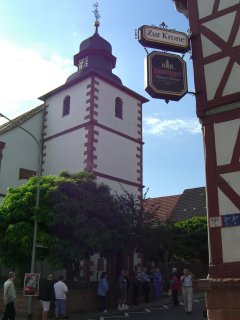
Semd church |
Margaretha’s parents, Johann Georg Müller III and
Anna Marie Schneider (born in
Semd) were married in Semd on Christmas day in 1830. There were eight
children born
in Semd to this Müller couple, but only four survived: Elisabetha,
Georg XVII, Anna
Marie and Margaretha. Nothing more is known of Elisabetha. Georg
married (to
Margaretha Müller, to add to the confusion) and had at least two sons
in Semd. Anna
Marie Müller married Johannes Vogel, VII in 1868. Anna Marie Müller and
her husband, Johannes Vogel, emigrated to the United States in 1870 to
settle in Freeburg, St. Clair County, Illinois where they raised their
six children. Margaretha’s parents both died in
Semd; her mother died in 1862 when Margaretha was not quite 20 years
old and her
father died in 1872. [Insert PHOTO OF THE POSSIBLE MÜLLER HOME]
Jakob Friedrich Zeisset married Margaretha Müller
in March 1864. At this time, Jakob
Friedrich was living at Sindolsheim. Margaretha was from Semd, which is
about 48
miles from Sindolsheim. Even with today’s modern roads and cars, the
trip from Semd to
Sindolsheim takes a little over an hour, so in Jakob and Margaretha’s
time, it surely took
twice as long as that. Semd is northwest of Sindolsheim. The marriage
of Jakob and
Margaretha took place in Adelsheim, about 9 miles south of Sindolsheim.
We don’t
know why the marriage took place in Adelsheim, although it was the
county seat for Sindolsheim. [insert MAP of Semd, Sindolsheim,
Adelsheim]
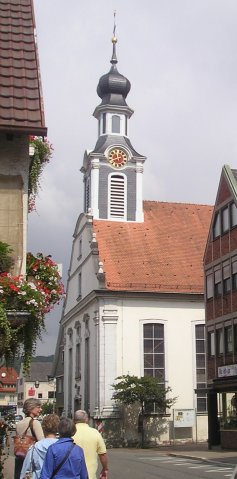
Adelsheim church, where Jakob Friedrich and
Margaretha were married |
The most likely explanation that we can propose
at this time is that
Margaretha was either attending or working at the girls’ school in
Adelsheim, or perhaps
she was a teacher. One of the sponsors for the marriage was a teacher
from the girls’
school, and this is the only clue we have for the reason behind the
location of the
marriage. If Margaretha lived in Adelsheim, it is much easier to
imagine how Jakob met
and courted her than if we assume that the young lady was living
several hours away
from his home. They were married in March and moved immediately to
Kreuzfeld.
Kreuzfeld is located about 38 miles east of
Sindolsheim, an hour’s journey by car today, in a district of Germany
that is called Hohenlohe. [insert Map of Sindolsheim and Kreuzfeld]
This district was named for the Hohenlohe family
which ruled the area until 1806 when it became part of Wuerttemberg.
There is a dialect of German that is spoken in this district,
Hohenlohisch, which is spoken by only a few of the residents of the
district today, but was probably the dialect the Zeisset children
spoke. The records for all things related to the Hohenlohe district are
located in an archive in Neuenstein [insert PHOTO of ARCHIVE],
not far from Schwäbisch Hall. The Hofgut Kreuzfeld was owned by the
Hohenlohe family, specifically Fuerst Hugo von Hohenlohe-Öhringen, when
Jakob Friedrich Zeisset moved there in 1864. All of the records related
to the business of Hofgut Kreuzfeld are now to be found at the
Neuenstein Archive, a discovery that was made late in 2006. This
information has significantly expanded our knowledge of life for the
Zeissets at Kreuzfeld.
The Hofgut Kreuzfeld records at the Neuenstein
Archive indicate that the lease of the farm extended from 1858-1870.
The tenant for that lease period, Andreas Kolb, died before the lease
had ended so that the property was then available. Records from the
city hall (Rathaus) in Schrozberg indicate that Johanna Zeisset, Jakob
Zeisset (tenant of the prince’s farm) and Isaak Zeisset all came to
live in the Schrozberg region in February 1864. On the 5th of March
1864, ten days prior to Jakob Friedrich Zeisset’s marriage to
Margaretha, Jakob Friedrich’s mother, �the widow of Jakob Zeisset�, and
her oldest son, Jakob Zeisset from Menzingen (using the town of his
birth or citizenship rather than the current residence at Sindolsheim),
assumed the rental of the Hofgut Kreuzfeld for the remaining six years
of the original lease. They were listed as “Wiedertäufer” (Mennonites)
and relatives of Gutspächter (tenant) Baer of Nesselbach and
Gutsbesitzer (landowners) Buehler and Schmutz of Obersteinach. The Baer
family at Nesselbach was Peter Baer (1806-1880) and his wife Katharina
Baer (1823-1901), discussed in a separate
chapter, with whom there was a remote family relationship. The
Schmutz family at Obersteinach was Jakob Schmutz (1817-1885) and his
wife Barbara Zeisset (1828-1884). Barbara was an aunt to Jakob
Friedrich. The Buehler family may have been related to Jakob Buehler,
who was Magdalena Zeisset Baer’s second husband at Niedersteinach.
Sisters Magdalena Zeisset Baer Bü and Barbara Zeisset Schmutz were
aunts to Jakob Friedrich Zeisset. Though it may be difficult to keep
these relationships straight, the primary reason for discussing them is
to show that there was usually some family connection when moving from
place to place for our Zeisset ancestors.
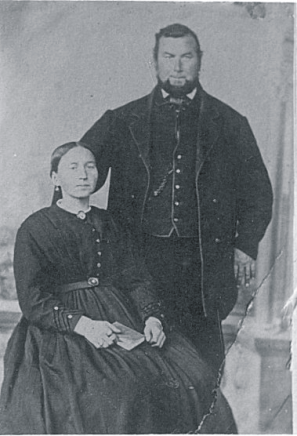 Jakob Friedrich Zeisset and Margaretha Müller Zeisset, c
1877 Jakob Friedrich Zeisset and Margaretha Müller Zeisset, c
1877 |
Jakob Friedrich and Margaretha
Zeisset lived in Kreuzfeld their
entire married life. Family stories have been passed down describing
Jakob
Friedrich as the manager of a large
estate. It has been told that the
estate consisted of 520 acres and
that Jakob Friedrich employed up to
72 men during harvesting and
planting. He was considered to be prosperous.
From information obtained in 2007 about the Hofgut Kreuzfeld, it
appears that this wasn’t always the case.
Mother Johanna and her oldest son, Jakob Friedrich entered the lease
agreement together in 1864.
The entire Zeisset family moved to Kreuzfeld from Sindolsheim,
including mother Johanna, Jakob Friedrich and his new wife Margaretha,
Isaak and his wife Bertha, Johannes, Daniel and Magdalena. Isaak lived
at Kreuzfeld from 1864 until 1867 when he returned to an estate near
his wife’s family. In 1870, the terms of the former lease under Andreas
Kolb at Hofgut Kreuzfeld were ended and Jakob Friedrich committed to
leasing the property from 1870 to 1888, so we can assume that all was
well at Hofgut Kreuzfeld at that time. By then, brother Johannes had
gone to Wiegelshof near Feuchtwangen in Bavaria to farm.
The photo of Jakob and Margaretha Zeisset
was likely made around 1877, as
Jakob looks to be about 40 years
old. That would have been between
the births of Bettie and Henry. Unfortunately the photo was not
dated.
Jakob Friedrich and Margaretha Zeisset’s first
child, Georg was born in November 1864. He lived only five hours. He
was likely named after Margaretha’s father, Johann Georg
Müller, or perhaps her brother, Georg. Eight months after the first
born, another son was
stillborn. One year after the second child, Johanna Luise was born in
July 1866. This is
Louise Zeisset who later married John Swart. She was named after her
paternal grandmother and her baptismal sponsors were Isaak Zeisset,
living at Kreuzfeld and Daniel Zeisset. In June 1867, a daughter Emma
was born. She lived about 3 weeks. Her baptismal sponsor was Johannes
Zeisset, who appeared to be living in Menzingen. Then Bertha was born a
year later in June 1868. She would eventually marry Juergen Nanninga.
Bertha may have been named after Isaak Zeisset’s wife, who was her
baptismal sponsor along with Isaak. Isaak and Bertha were living at the
Rosshof at this time. A stillborn son arrived the following year in
May. In another ten months, Elisabeth Zeisset was born in March 1870.
Her baptismal sponsors were her uncles, Johannes Zeisset living at
Wiegelshof and Daniel Zeisset living at Menzingen. She later married
George Weller.
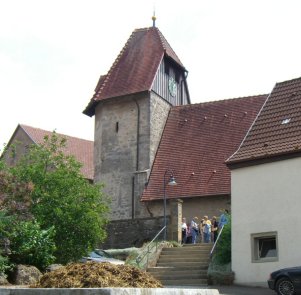
Krailshausen church, where Margaretha was
burried |
The Zeisset family belonged to the church at
Krailshausen, only 1-2 kilometers (about a mile) away. The records for
this church were maintained in Schrozberg, the larger town also a short
distance away (3.5 kilometers). The births and baptisms are listed then
in the Schrozberg church records but these records show that all of the
Zeisset children were actually baptized in the home at Kreuzfeld, where
they were born. [insert copy of birth record]
In case the reader is not keeping track, the
babies to this date were all born a year or less
apart. Infant mortality was naturally higher in that time, with little
or no prenatal care. The
cause of death often listed for babies who survived past birth is
“gichter”, meaning
convulsions, which could have been a variety of serious illnesses for
an infant. It is doubtful that Margaretha, was fully recovered from one
pregnancy before she found herself pregnant again. Pregnancy and
childbirth were considered to be very dangerous times in a woman’s
life.
At the time of Elizabeth’s birth, Margaretha was
27 years old. The next baby, another
stillborn son, was born in September 1871. Then it would be over two
years before
Georg Jakob was born in December 1873. His baptismal sponsors were
Georg Seiffert of Kreuzfeld and Daniel Zeisset of Menzingen. He was
called Jake and later married Christine Bohnenblust. Jake was surely
named after both of his grandfathers. In April 1875, Barbara was born.
Her baptismal sponsors were Georg Seiffert and her uncle Isaak Zeisset,
living at Rosshof. She also used the name Babette, was mostly called
Bettie and would later marry Ludwig Hoerman. Henry Zeisset was born
almost three years later in February 1878. His baptismal sponsors were
Georg Seiffert, of Kreuzfeld and Georg Müller, his mother’s brother,
living in Semd. He had a third sponsor, Isaak Zeisset, now living at
Eichenau.
By now mother Margaretha was 36 years old and father
Jakob Friedrich was 41 years
old, with six children in the home. Louise was nearly 12 years old when
Henry was born. Margaretha probably had a least one hired woman or
young lady to help with the
household chores and the cooking, which may have included feeding the
hired men. If the
Zeissets were considered prosperous and if Jakob Friedrich employed up
to 72 men,
surely Margaretha also had domestic help. In that era, unmarried young
female cousins
may have also lived with the family. Where did the children attend
school? Margaretha
was surely educated, because of her connection to the girls’ school in
Adelsheim. Did
she have time to teach the children herself? In the photo of Margaretha
and Jakob
Friedrich, Margaretha
is holding a book. Does this indicate the
importance of learning
to her? A book Schrozberg purchased on the Zeisset Family
Tour in 2006 discusses the school in Krailshausen, so it’s quite likely
that the children attended school there. The Krailshausen schoolhouse
was built in 1876.
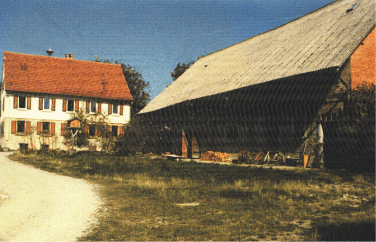 Former Zeisset residence at Kreuzfeld, 1985 Former Zeisset residence at Kreuzfeld, 1985 |
There is still a home at
Kreuzfeld where the
Zeissets lived, though
the occupant of the
home in 1985 told this
writer that she had gone
to nearby Schrozberg to
research the history of the Kreuzfeld house and determined that it was
not old enough to
have been the home where the Zeisset children were born. She said that
the house was
100 years old in 1985 and that the previous home had burned. We have
not seen
documentation regarding the age of the home, but if the original house
burned, the
current house is likely a close replica.
In 2008, a copy of the floor plan for the house and
a diagram of the house were found at the Neuenstein Archive. Jakob
Zeisset built a new house on the estate in 1870 and this is the floor
plan for the house which was built. The floor plan and the description
of the house provide us with an accurate description of the home
established by Jakob Friedrich and Margaretha Zeisset. [insert PHOTO OF
FLOOR PLAN]
The door to house was situated on the east side of
the house. On the 2006 Zeisset Family Tour, members of the Swart family
had photographs taken at this door. PHOTO OF SWART FAMILY The entry to
the house contained a stairway to the upper floor was located
immediately to the right of the entry door. On the left hand side of
the entry was a door to the “Wohnstube” or living room. The floor of
the living room was wooden. On the north wall of the room, a bench was
attached, as was the custom in that time. There were three lead glass
windows which provided light for the living room. The room was heated
by an Eremitageofen, which was an iron stove connected by a pipe to the
kitchen on the other side of the wall. This stove stood on the same
wall as the bench, but on the other side of the door. Those who were on
the 2006 Zeisset Family Tour will recall visiting the open-air museum
at Wackershofen and learning about this room in the family home. There
was a table and chairs here where the family ate meals, as well as a
cupboard with dishes and a loom or spinning wheel. In this room, the
family rested and worked at chores, particularly in the winter. In the
Zeisset home, there was certainly a cradle in this room. We can imagine
that the mother, Margaretha, often read stories to her children in this
room. [insert PHOTO OF LIVING ROOM FROM WACKERSHOFEN]
The living room had a door which opened into the
large bedroom of the parents which also was heated by a stove. Just off
of this room was a smaller bedroom, or nursery. Another door from the
master bedroom led to a smaller room to the north was possibly a
dressing room and storage room.
Returning to the entry hall, the kitchen doorway was
directly across from the entry to the house. There were two small
windows which provided light for the kitchen. To the right of the
kitchen door and on the north wall of the house is the baking oven. The
actual oven was located outside of the house walls in order to decrease
the possibility of fire in the house and to decrease the temperature in
the house during the summer months. The drawing of the house from 1870
has a diagram of the oven with its connection to the chimney. It
appears that the cooking stove was positioned on the wall opposite the
oven which would have been connected to the central chimney. A door on
the west wall of the kitchen led to the pantry (Speisekammer).
One other important feature of the ground floor of the
house is located in the entry with a door opposite the living room and
to the right of the kitchen. On the floor plan, it appears as a small
hall and is labeled “abbord” which is a misspelling of Abort, a word
used at that time for toilet. This was the indoor toilet. This was a
feature we also viewed at the open-air museum. It is interesting to
note that our Zeisset immigrants grew up with an indoor toilet in
Germany, but in America they had to put on their heavy coats in the
winter to make a quick run to the outhouse several yards away from the
nice warm home. [insert PHOTO OF WATER CLOSET FROM WACKERSHOFEN]
Eleven steps led to the upper floor of the Zeisset
home. Immediately to the right of the stairs on the upper floor is the
door to the upstairs toilet. A central hallway provides access to the
rooms upstairs which where divided into sleeping rooms. Boys slept in
one room, girls in another and if there were servants, they slept in
yet another room. Smaller rooms on this second floor likely provided
storage.
There was a third floor and it is likely that servants
had their sleeping quarters here as well. Then there was a small attic
above that which had a window on each end.
At this point, a disclaimer must be made, in that the
floor plan shown in the photo was the original drawing by the builder.
Jakob and Margaretha altered the floor plan by moving some of the walls
and making the rooms different sizes than what is depicted here. Only
the original floor plan was photographed and so there is another reason
to return to the Archive at Neuenstein, to get the floor plan as built
by the Zeissets.
The house was described in 1880 as being 23 feet long
and 33 feet wide with the ground floor and one floor over that, what we
would call a two story house). There was also a small basement under
the house under the living room and master bedroom.). There was a
previously built half-timbered home on the property that measured 78
feet long and 35 feet wide. The Zeisset family must have lived in this
home when they first moved to Kreuzfeld and it was situated in the
location where the newer barn sits on the west side of the farm today.
Over the years, this old house was converted into a sheep stall. It was
probably a barn house when the Zeissets first lived in it.
South of the new house, where the older barn sits on
the east side of the farm today, Jakob Friedrich built a stable. It may
be the same building as can be seen today. [insert PHOTO OF THE BARN
DRAWING AND OF THE BARN TODAY ] This stable was built on the site of
what was previously a barn house. The stable was built before 1869 to
accommodate 36 head of cattle on the north part and 6 horses on the
south end. The 1880 diagram of the Hofgut Kreuzfeld buildings indicate
that a new barn with a sheep stall was to replace the old house. Just
north of the old house is an old horse stable and a swine building
which runs between the horse stable and the calf barn which was built
in 1841. To the east of the horse and cattle stable is a woodshed.
South of the stable and woodshed is the site of a barn, built in 1855,
which was burned sometime between 1878 and 1880. [insert 1880 FARM
DIAGRAM]
Many farm homes in Germany were “house-barns”, with
livestock housed on the ground
floor in the winter and the family living quarters on the second floor.
. The two older homes on the property were house-barns. The heat from
the animals would help warm the human occupants above in the winter. In
the summer, well, we can imagine that flies were plentiful, but the
livestock would likely have been outside. The new Zeisset home however,
was not a house-barn, but a building separate from the barn.
Diagrams of the farm which show changes made at various
times can be found at the Neuenstein Archive. There are diagrams from
1869 before the new house was built, 1870 after the house was
completed, 1878 when an inventory was done and then the last from 1880.
[insert DIAGRAMS AND EXPLANATIONS]
We can wonder about the day to day activities of the
family. Obviously Jakob Friedrich
was busy with the management of the estate and his workers. From
stories of our Bletscher cousins, we know that it was not unusual to
arise at 2:00 in the morning to mow hay in the meadow, so farming was
certainly not easy work. The Zeisset home previously had a bell at the
top which would be rung indicating to the field workers that it was
time to come in for a meal.
The Zeisset home was surrounded by orchards. There
were also vegetable gardens, farming ground, meadows and pastures.
Jakob Friedrich grew hay, “straw”, fruit, potatoes and root crops.
Sheep were his primary livestock. The standard unit of measure for land
during this time was the “Morgen”. The size of a Morgen was initially
determined by the amount of land that could be plowed with a team of
oxen in one morning. The size of a Morgen varied depending on what part
of the country the land was in. For instance, in Northern Germany, a
Morgen was equivalent to two-thirds of an acre. In the south, where
Kreuzfeld is located, a Morgen was just less than 1.5 acres. The
records show that Jakob Friedrich was in charge of 207 (and an eighth)
Morgens and 10.8 Ruten. A Rute was a distance of 3 to 4.5 meters. So
Jakob Friedrich farmed around 290 acres, not the 520 acres the family
legend described. The farm rent (Pachtgeld) from 1877 to 1878 was
2640.25 Marks. The conversion rate in 1913 was 4 Marks to the US
dollar, so that the rent for a year was about $660. In 2006, accounting
for inflation, that would be $12059. [insert Photo of Deutsch Mark]
The children would have
been involved with some chores in addition to their studies. Margaretha
probably spent
most of the time caring for the youngest children. Since Jakob
Friedrich’s brothers were
living nearby, the families likely visited each other with some
frequency. Both of Jakob
Friedrich’s brothers had named a son “Jakob Friedrich” reflecting the
level of respect
they had for their oldest brother. We know that the cousins maintained
contact with the
six who emigrated to America, so we can assume that good friendships
developed while
all were still in Germany.
In the year 1881, Margaretha Zeisset delivered her
last child on the 19th of February. Bettie Zeisset Hoerman
recalled the day of the birth. She was sent outside to play, but
sneaked
back into the house and recalled seeing the lifeless body of her baby
brother lying in a
washtub. The midwife reportedly said, “Oh, she would have to see that!”
She told this
story to her granddaughter Betty Cott. The church records tell us that
the baby was
“frühgeburt” or premature, and that the mother, Margaretha, died the
day following the
birth of the infant. While the midwife was present for the birth of the
child, perhaps a
physician was summoned when the situation with the mother’s health
appeared to be
serious. But in those days there were no blood transfusions, there were
no antibiotics and
there was little help for a difficult birth. The Zeisset home would
have been very somber
and perhaps the children were gathered around the mother. Jakob
Friedrich may have
been by his wife’s side continually, but she slipped away from him at
7:00 o’clock in the
morning after giving birth to the twelfth child.
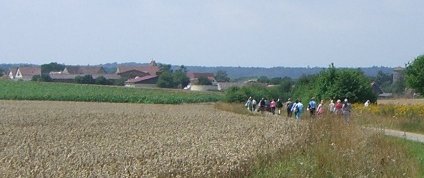
Traurigweg to Krailshausen |
The Zeissets attended church in nearby Krailshausen,
as documented by the
confirmations of Louise and Bertha in the church records, and this was
where Margaretha
was buried on the 22nd of February at 1:30 in the afternoon.
[insert photo of the grave]
Relatives probably brought
food and served a meal at noon. There would have been a funeral service
in the
home with all the relatives and friends there to view the body and
remember Margaretha
Müller Zeisset. Then the mourners processed over the “Traurigweg” or
path of grief
behind a cart bearing the coffin to the cemetery in Krailshausen.
Margaretha was 38
years old at the time of her death. Her parents had died years before.
One sister had
emigrated to St. Clair County, Illinois in 1870 with her husband John
Vogel and their two
children. Margaretha’s brother remained in Semd and may not have
received word of her
death prior to her funeral.
Jakob Friedrich was left with his six children:
Louise 14 years of age, Bertha 12 years of
age, Lizzie 9 years of age, Jake 6 years of age, Bettie 5 years of age
and Henry 3 years of
age. Jakob Friedrich must have been paralyzed with grief and at
somewhat of a loss as to
what to do with his children. He was now 43 years old and had spent his
life farming and
managing farming operations. Johanna Zeisset was now 64 years old and
may not have
been much help in caring for her 6 grandchildren. Jakob Friedrich
probably had very
little to do with child rearing while Margaretha was living.
At some time prior to 1878, Jakob Friedrich experienced
some difficulties in his farming operation. Apparently the main
contributing factor was a bad fruit crop, due to too much moisture.
Family illness was listed as a factor to the financial problems he
began to encounter. Certainly there were many pregnancies and infant
illnesses and death. On the 29th of July, 1878, the financial strains
had become so great as to require the appointment of managers to
oversee the operation of the farm. Jakob Friedrich’s brothers, Isaak,
now living at Eichenau, and Johannes, now living at Erlach, were named
as the administrators of the Hofgut Kreuzfeld. Essentially from that
time on, Jakob Friedrich worked for them. There are several documents
pertaining to these arrangements and there are letters from Jakob
Friedrich as well as Isaak. (insert Copy of JFZ letter) Then in
February 1881, Margaretha died, adding yet more to the burdens of Jakob
Friedrich.
Things never really improved for Jakob Friedrich
financially. On the 9th of November 1883, Jakob Friedrich Zeisset
declared bankruptcy at noon in Langenburg, a town 20 kilometers
southwest of Kreuzfeld. [insert photo of rathaus] From that time on, he
is not mentioned in the records of the Hofgut Kreuzfeld which was then
officially the responsibility of his brothers, Isaak and Jakob. At that
time Isaak was still living in Eichenau, while Johannes was now at
Niedersteinach.
During this time in Germany, there would have
been much talk about emigrating to
America. From 1880-1889, nearly 1.5 million Germans left their homeland
for better
opportunities in America. In the previous century and first part of the
1800s, many
people left Germany for religious reasons, hoping to find a land with
more tolerance
where they could live the principles of their chosen faiths.
In the mid-to-late-19th
century, emigration from southern Germany was often prompted
by the inheritance laws of the time. The possessions of the parents
would be divided
evenly among all the children. If, for instance, a father owned 100
acres and had six
children, each child would inherit a little over 16 acres. For Jakob
Friedrich, these laws
would not have played a role as he didn’t own his land. But certainly
he was considering
what he would be able to leave to his children. It would have been
difficult to purchase a
large farm in those days, and as we now know, Jakob Friedrich Zeisset
was financially destitute in 1883 and forced to declare bankruptcy.
What sort of life could he provide for his children? Prior to the mid-19th
century, Mennonites were not allowed to
own land in Germany, so there had been no accumulation of real estate
by Jakob
Friedrich Zeisset.
When we consider the extended family of the
Zeissets, there were several who had
already emigrated to America. In Margaretha’s family, a sister Anna
Maria Müller, her
husband, Johannes Vogel, and their two children left Germany for
Illinois in 1870. While none of Jakob Friedrich’s siblings ever left
Germany, he had several cousins who
went to America. His aunt Magdalena Zeisset Baer, living in
Niedersteinach, had a son,
Henry Baer who left Niedersteinach with his brother-in-law Peter Baer
(who was married
to Henry Baer’s sister Magdalena). [insert TABLE of family to show
relationship]
Henry and Peter Baer came to America in May 1880
and went directly to Dickinson
County, Kansas. The letters from these relatives must have sounded
enticing. There was
land available “for the taking”. In the booklet, “A History of the
David Bletscher
Family” written by Christ Bletscher and Laura Llewelyn in the 1960’s,
the following
statement was made about communication from Henry and Peter Baer,
“These men, after
coming to America, would write inviting letters to their loved ones in
the Fatherland,
telling them what a wonderful land America was. Here in America a man
could take a
gun, walk over the prairie, get his venison, all he wanted. Such a
thing was against the
law in Germany.” The author, Christ Bletscher’s mother was Anna Baer,
sister to Henry
and Magdalena, married to David Bletscher.
Looking to the church records, we can see that
Bertha Zeisset (later wife of Juergen
Nanninga) was confirmed at the church in Krailshausen in April 1882.
This was over a
year after her mother’s death, so we can be fairly certain that she was
living at Kreuzfeld
with the rest of the family at that time. Louise Zeisset (later John
Swart’s wife) had been
confirmed in the same church in April 1880. One would assume that many
of the
household duties and perhaps oversight of the younger children would be
the
responsibility of these two oldest daughters. It is also quite possible
that Jakob Friedrich’s mother, Johanna, was living with his family at
this time. We know that she moved with her family to Kreuzfeld in 1864
and at some time prior to 1883 was living in Schrozberg. She is not
listed in the financial arrangements of the Hofgut Kreuzfeld after the
initial rental agreement.
|
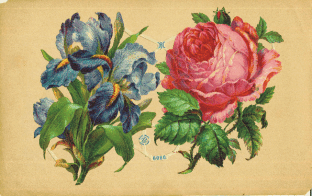 Page from Louise’s autograph book Page from Louise’s autograph book
|
The next event that we can verify in the Zeisset
household was the departure of Louise
for America. Lee Swart has an autograph book that belonged to his
grandmother Louise, of Posie-Album, that belonged to his grandmother
Louise. It is filled with pretty pictures that have apparently been cut
from greeting cards with a
very fine scissor and is filled with verses from family and friends. It
was disappointing
to learn that there were no “personal” messages to Louise, but
none-the-less, it is a
treasure trove of information as to family members and their
residences.
The book must have been given to Louise, perhaps by
her mother, for the earliest
signature in the book is from September 10, 1879 and is that of
Margaretha Müller
Zeisset. It is a verse about being on the sea of life and looking to
God for strength. It is
signed “from your Mother”, Margaretha Zeisset.
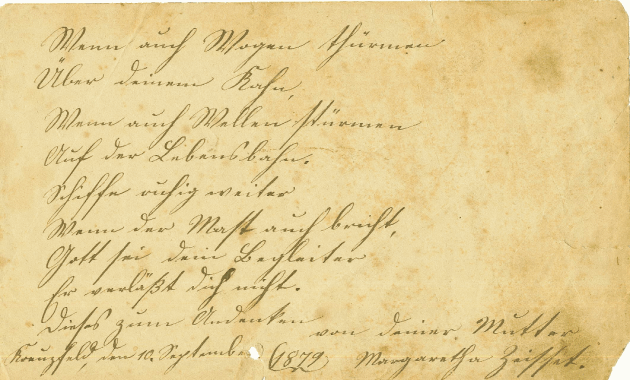 Verse signed by Margaretha Zeisset, 1879 Verse signed by Margaretha Zeisset, 1879
|
The next entries in the autograph book are from
1883. Louise arrived in New York City
on the steamship Belgenland July 13, 1883. There are a number of
entries in the
autograph book from June 1883, so we can assume that there were several
farewell
gatherings for Louise. Was it Louise’s idea to go to America? Her
obituary says that she
“came to the United States with friends at the age of sixteen. Her
first two to three years
in this country were spent in Pennsylvania, moving then to Riley Co.,
Kansas in 1885."
From the ship’s passenger list, Louise is in a group of thirteen
Germans who list their
destination as Philadelphia, but none of the names are familiar to us.
It was likely that
her trip was arranged by the ship’s captain and that she was to work
for a wealthy family
in Pennsylvania for a specified period of time in order to pay for her
passage. Or did Jakob Friedrich use the last of the little money he had
to pay for her passage? His bankruptcy was declared in November of
1883, so perhaps he was able to help a little with her monetary needs
the previous July. Was she to
go to America to lead the way for the rest of the family?
Looking at the autograph book, we see that on June 9th,
1883 Louise was in Eichenau
where her uncle Isaak Zeisset lived with his family. Her book is signed
on that day by
her cousins, Ludwig and Heinrich Zeisset, sons of Isaak and Bertha
Zeisset. Did she
spend the night with the Isaak Zeisset family? For on the next day, the
book is signed in
Eichenau by Aunt Bertha Zeisset, Isaak’s wife. A rough translation of
the verse written
by Bertha is:
|
|
God bless your heart and soul,
That sorrow and darkness stay far away;
That Father’s eye and Mother’s hand
Will not fade in foreign land.
God bless you.
Forever in my thoughts, your loving aunt,
Bertha Zeisset |
Also on the 10th of June, Louise
traveled to Niedersteinach where the following signed
her book: Aunt Elisabeth Bär Zeisset and her husband Johannes Zeisset,
Marie Moser
(who later came to Kansas with her parents and was married to Christian
Bletscher in
1884), and a friend Katharine Abendschein. Later that day, Louise was
in Obersteinach
where her father’s aunt Barbara Zeisset Schmutz lived with her family.
[insert FAMILY TREE]. There Louise’s book was signed by her great aunt
Barbara Zeisset Schmutz and
Barbara’s daughter Anna. On the following day, June 11, 1883, the
autograph book was
signed by Magdalena Bühler in Niedersteinach, Louise’s great aunt,
Magdalena Zeisset
who had married Matthäus Baer. They were the parents of the Baers who
also emigrated
to Kansas: Henry, Lena, and Anna (who married David Bletscher). At this
time in 1883,
Magdalena Zeisset Baer was the widow of her second husband, Jakob
Bühler. [insert FAMILY TREE] She was 63 years old now, and died
the following year in January at Niedersteinach.
In the autograph book, the next farewell gathering
is on June 24, 1883 in Krailshausen. A friend, Mina Albrecht wrote a
verse titled “Despair not!” perhaps an indication of
Louise’s anxiety about her upcoming trip. On that day in Krailshausen,
the book was
also signed by friends, Paulina and Marie Münz, Rosine Weber and Marie
Belschner. These were likely childhood friends, schoolmates and friends
from church. Paulina Münz was born at Krailshausen on the 11th of March
in 1867, so had grown up with Louise who was born in July 1866. Did
these friends write letters back and forth from Germany to America once
Louise made her new home in America?
On June 25, 1883, Louise’s brothers and sisters
signed her book in Kreuzfeld. There is a
verse written in one handwriting and it appears that the signatures are
in another “from
your three siblings”, Jakob, Babette and Heinrich (Jake, Bettie and
Henry). There’s a
lengthy entry from sister Bertha, and another from sister Lisette
(Lizzie). “Aunt” Lena
Baer, wife of Peter Baer who was already in Kansas, signed the book at
Kreuzfeld. This
Lena Baer was actually a cousin and not an aunt. She was the daughter
of Magdalena
Zeisset Baer Bühler and emigrated the following year with her children
to join her
husband in Kansas.
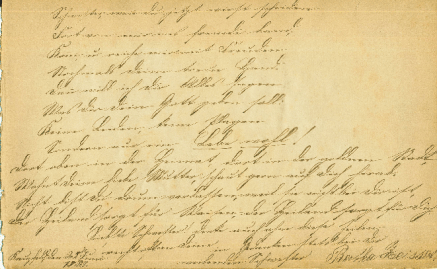 Page signed by Bertha Zeisset, Louise’s sister
Page signed by Bertha Zeisset, Louise’s sister |
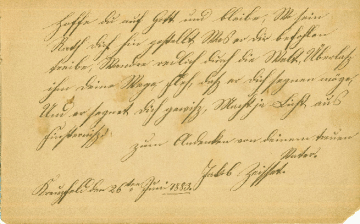 Page signed by Jakob Zeisset, 1883
Page signed by Jakob Zeisset, 1883 |
There are two signatures on the 26th of
June and we imagine
this was the day when Louise
actually left Kreuzfeld. One
verse in very bold writing is
signed “a remembrance from
your devoted father” Jakob
Zeisset.
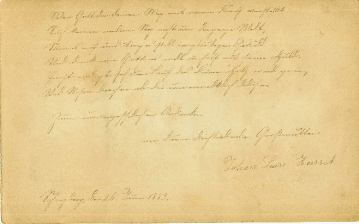 Page signed by Johanna Luise Zeisset, Louise’s
grandmother, 1883
Page signed by Johanna Luise Zeisset, Louise’s
grandmother, 1883 |
The last verse written in
Germany on the same day was
from Jakob Friedrich’s mother,
Louise’s grandmother, Johanna
Luise Epp Zeisset, written in
Schrozberg, so we can assume
that Johanna was living in
Schrozberg. Did Louise
perhaps depart by train from
Schrozberg? Schrozberg is
about 350 miles from the port
of Antwerp from which Louise
sailed. Did she meet friends in
Schrozberg and travel with
them to Antwerp? Rail was the most likely method of travel for Louise
from Kreuzfeld
to Antwerp. Imagine the excitement and anticipation of going to America
for this 16-year-old young lady. Imagine also the sadness in leaving
all of her family and the fear of
traveling farther than she’d ever traveled in her young life, to a
foreign land where
German was not the preferred language. How brave she must have been.
She traveled
with her one trunk, along with 555 other passengers on the SS
Belgenland. She arrived
in New York City on Friday the 13th of July, entering
through Castle Garden as it was
nearly a decade before Ellis Island would open.
There are a few more clues in Louise’s autograph
book. The first dated entry in America
was in German from a friend, Friedrick Fritz in Valencia, Pennsylvania
on February 3, 1884. There was a Friedrich Fritz was born at Waldenburg
in 1873, but as he would have only been 11 years old in 1884, this was
not likely the same person. Waldenburg is where Louise’s aunt Magdalena
Zeisset Belzner Sonder lived and where her grandmother, Johanna Epp
Zeisset eventually died. Friedrich Fritz emigrated from Waldenburg with
his father, brother and sister in November 1882. Presumably they knew
the Zeissets when they lived in Germany. This Fritz family eventually
lived in Riley County, Kansas as well. Louise’s destination as listed
on the ship record was Philadelphia. But we’re not
certain where she worked. Did she remain in Philadelphia or did she go
elsewhere in Pennsylvania? Valencia is just north of Pittsburgh, the
opposite end of the state from
Philadelphia. The book is also signed by Matilda Brand on the same day,
February 3, 1884. A biography of John Swart in the History of Nemaha County,
states that Louise
came to America in 1882, worked as a domestic for three years in
Pittsburgh,
Pennsylvania for wages from $1.50 to $2.50 per week, and then worked a
year in Clay
Center, Kansas prior to her marriage. This information would have been
provided
directly by John and Louise for the book published in 1916. Louise
married John Swart
in February 1886 in Leonardville, so the time intervals from the
biography are not
correct. We know that she arrived in the United States in 1883, so she
may have worked
in Pittsburgh for two years and then for a time in Clay Center.
Maria Fritz, sister of Friedrich, was living in Clay Center in 1883,
married to Jacob Heer. The half-sister of Maria and Friedrich was named
Barbara and she was living in Clay Center having married J. W. Hood in
Clay Center in 1883. Mrs. J. W. Hood signed Louise’s book in September
1886. Could it be that Louise had worked for one of these two sisters
when she moved to Clay Center?
We return our attention now to Germany in the
summer of 1883. Louise has just left for
America. The Zeisset family certainly must have missed the oldest
daughter/sister. Over
the next year, Lena Baer and her children were preparing to travel to
America to join the
husband and father, Peter Baer. Lena and her family would be traveling
with her sister
Anna Baer, now married to David Bletscher.
With all this talk of emigration and plans
being made for the trip, perhaps Jakob
Friedrich Zeisset was thinking of traveling to America as well. He
owned no land, his
wife was dead, he was bankrupt, his oldest daughter was now living in
America, and several of his cousins
were either living in America or would soon be going there. Could it be
that he came up
with a scheme to make enough money to pay for the fare for himself and
his five children
to also emigrate to America? We will never know for certain what
motivated Jakob
Friedrich to set his barn on fire in order to collect the insurance
money, but this proposal
seems almost plausible. And that is the crime with which he was charged
and for which
he was incarcerated.
From information obtained in February 2007 at the
Neuenstein Archive records, we now know that Jakob Friedrich was in
desperate financial straits and was quite likely guilty of burning his
barn in an attempt to meet the financial debts he was encountering,
trying to avoid bankruptcy. As of the present time, the actual date of
the alleged barn burning is not known. The story passed down to us is
that Jakob’s barn had burned down previously and that it had been
rebuilt with the insurance money. According to the 1878 and 1880 farm
diagrams, there was indeed a barn which burned in that time interval
and this is likely the barn mentioned in the story about a previous
fire. It doesn’t appear that a barn was rebuilt however.
Presumably, some time in the summer of 1884, Jakob
Friedrich was said to have ignited a wagonload of hay and run it into
his barn. This is the story told by Alfred Kuppler, the farmer who
was renting the former farm of Jakob Friedrich Zeisset in 1985. A
letter had been written to Dr. Kuppler just before the 2006 Zeisset
Family Tour, but he was very ill at that time and died shortly after.
[insert PHOTO OF DR. KUPPLER AND HIS GRAVE] Dr. Kuppler’s account
matches a story recounted in Merton Zeisset’s book, “Our First Century
in America”: “…Jakob was in
the tavern in Kreuzfeld when the cry was sounded that the barn was
afire. He is said to
have made a careless comment, something like ‘Let it burn; it’s covered
by insurance!’”
Another possibility set forth in Merton Zeisset’s
book is that “the village brickmaker was
accused of setting the fire because he was short of work and hoped for
the job of making
brick for rebuilding."
It seems quite certain that there was a fire
and that Jakob was implicated in causing it for
fraudulent purposes. He was imprisoned in Schwäbisch Hall in the
Landesgefängnis
(regional prison) on the 26th of August, 1884 with a
sentence of one month and 15 days
for the crime of “Betrug” or fraud. In reviewing the prison day book,
we find that six
others were imprisoned on that day, with sentences ranging from 36 days
for vagrancy to
seven weeks for begging (which commonly appears as a crime in the
book). One other
man received a sentence of four months for theft and another man six
months for
robbery. Yet another man received a sentence of one year, four months
for robbery. So
Jakob Friedrich Zeisset’s sentence was not a lengthy one in comparison.
Perhaps they
took into consideration his children who were without
their mother.
The prison would have been a terrible place.
In August, it would probably have been very hot, dank and filthy. In
addition to sharing his accommodations with other prisoners, he would
have
shared his space with rats. Rats carried lice and lice carried typhus,
a common disease of that time. Symptoms of typhus would have included
severe headache, body aches, fevers
and a rash. Over a period of about two weeks, kidney failure and
pneumonia would be
likely. And so it was that on the evening of October 6th at
the end of his sixth week of a
seven week prison sentence, Jakob Friedrich Zeisset died of typhus.
Another prisoner
died the same day of typhus. The City Hall in Schw�bisch Hall has a
communication from the prison dated the 7th of October 1884 which
states that the prisoner Jakob Zeisset, born the 31st of May 1837,
evangelical (or Protestant), widower, tenant farmer at Kreuzfeld,
citizen of Menzingen, died on the 6th of October at 5:30 p.m.
How did the family learn of Jakob’s death?
They probably
knew he was ill, if they were allowed to visit him; but we don’t know
if visitation would
have been allowed then as it is now. It is likely that one of the
brothers was informed of
Jakob’s death and it was his sad job to let the children know that they
were now orphans.
We don’t know if a funeral was held for Jakob Friedrich Zeisset, as his
death is not indicated in the individual death records for the
Krailshausen church. His death is recorded on the family group record
in the Kreuzfeld records (with Krailshausen and Schrozberg). The record
tells of his death in Schwäbisch Hall at the prison from Typhus, but
also remarks that he was not a native of the local population. On the
Zeisset Family History tour in August 2006, the previous custodian of
the church at Krailshausen showed the location of the former grave of
Margaretha Zeisset and distinctly remembered that her husband was
buried in the same grave, but he recalled the name as Georg. This was
the name of the first-born son. He recalled when the grave was turned
over to another family in 1969, the family currently living on the
Hofgut Kreuzfeld. In February 2008, a visit to the City Archive of
Schwäbisch Hall, previously an unfruitful visit, turned up the burial
of Jakob Zeisset on the 9th of October in the Nikolaifriedhof, the
cemetery in the city of Schwäbisch Hall, with the pastor listed as
Ströbel. PHOTO OF THE NIKOLAIFRIEDHOF
(PHOTO of grave)
Interestingly, Lena Baer, her children, David
and Anna Bletscher and their son Christian
left Germany for America on the 27th of August 1884 as told
in “The History of the
David Bletscher Family”. This was one day after Jakob Friedrich’s
imprisonment. They
would have needed to depart Niedersteinach several days before that in
order to reach the
port in Bremen. Did they know of Jakob’s alleged crime prior to their
departure? Who
wrote to inform them? Who wrote to tell Louise of her father’s death?
There are many
questions, but few answers.
We do know a little bit about the lives of the
orphaned Zeisset children in Germany. The
children were presumably taken in by their uncles immediately upon
Jakob’s
imprisonment, or possibly before. Uncle Johannes Zeisset lived with his
wife Elisabetha Baer at
Niedersteinach. Elisabetha’s sisters, Lena and Anna, had recently
departed for America
as previously mentioned. The mother, Magdalena Zeisset Baer Bühler, had
just died in
January 1884. Johannes and Elisabetha had three children of their own,
but had room for Bettie and Henry
Zeisset.
Isaak Zeisset was actually the godfather of Bettie
and Henry, but he would not be able to
take all five children. From the church records, we know that Lizzie
was confirmed in
April 1884 at Lendsiedel, where Isaak and his wife, Bertha attended
church. [insert photo of Lendsiedel church] So Lizzie was living
there before her father’s imprisonment in August of the same year. Jake
also went to Eichenau to live and was confirmed at Lendsiedel in April
1887.
We don’t know where Bertha lived after her
father’s imprisonment. Johanna Epp
Zeisset, Jakob Friedrich’s mother, grandmother of the six orphans was
living at the time
of Jakob Friedrich’s death. She had presumably been living in
Schrozberg, based on the
entry in Louise’s autograph book. Did Bertha go to live with her?
Johanna had but one
daughter Magdalena, sister to Jakob Friedrich, Isaak and Johannes. This
Magdalena was
living in Schrozberg at the time of her first and second marriages
(1873 and 1881), and the Schrozberg church records indicate that she
moved to Fasanenmühle by Waldenburg in August 1887. Johanna Epp Zeisset
died at Fasanenmühle on January 27, 1889, so we can assume that she
went there to live with her daughter, Magdalena.
Less than a year after their father’s death, Bertha
and Bettie embarked on their journey to
America. It’s possible that the Baers were able to earn enough money in
America to
assist in paying for the passage for the two girls. Perhaps Uncle
Johannes helped in
paying the travel expenses as well. Bertha was quite likely working and
earning at least a
little bit of money. Bertha was almost 16 years old and Bettie was 10
when they boarded
the SS Fulda in Bremerhaven to leave for America. This was the exact
ship on which the
Baers and Bletschers traveled less than a year earlier. On the ship’s
record, Bertha’s age
is listed as 17 and Bettie’s is listed as 8. Mertons Zeisset’s book
says that Bettie would
have traveled for half price if accompanied by one paying full fare.
Between them, they
had one piece of luggage. Imagine the arrival of these two German
children in New
York City on Saturday, the 6th of June, 1885. They certainly
had instructions on what to
do upon their arrival. Did a kind stranger help them or were they just
two very capable
young women? It is told in Merton Zeisset’s book that the Baers met
Bertha and Bettie
at the train station in Leonardville. They lived for a brief time at
Alida with the Baers,
but then Peter and Lena Baer moved to Leonardville and we know that
Bettie lived with
this family for a time. Bertha was employed by a family in
Leonardville, headed by the German merchant Richard Burk, until
her marriage to Juergen Nanninga on the 26th of March, 1886.
Half of the orphaned Zeisset children still lived
in Germany at this time in 1885. We
assume that Lizzie and Jake remained with the Isaak Zeisset family the
entire time prior
to their emigration. Lizzie was 15 years old and Jake almost 12 years
old in 1885. They
would likely have been helping with the work in the Zeisset home in
Eichenau and
perhaps they were earning the money it would take for their fares to
America. Isaak and Bertha moved their family to the Schlossgut in
Darstadt, just south of Würzburg in Bavaria, as previously noted in
February 1888. [insert PHOTO OF DARSTADT] As this village had only a
Catholic church, the Zeissets belonged to the church in nearby
Winterhausen. [insert PHOTO OF WINTERHAUSEN CHURCH] Jake Zeisset lived
in Winterhausen only two years before he left Germany forever.
Sixteen-year-old Jake Zeisset arrived in New York
City, through Castle Garden, on
February 26, 1890, a Wednesday. He arrived in Leonardville on the 6th
of March, 1890. A notation in the March 13, 1890 edition of the Leonardville
Monitor, reports that “Jacob
Zeisset, brother-in-law of John Swart arrived here last Thursday from
Germany to make
his home in glorious Kansas, under the grand old flag of freedom.” Jake
probably lived
for a short time with the Swart family since they are mentioned in this
way in the
newspaper.
Lizzie Zeisset was also living at Eichenau with the
Isaak Zeisset family when they moved to
Darstadt. This village was about 60 miles north of Eichenau, with
Kreuzfeld half-way
between the two. Isaak Zeisset employed a young man named George
Weller. George was
born in Onolzheim, Germany, about 20 miles directly south of Kreuzfeld
and 10 miles
southwest of Eichenau. It is likely that he worked for Isaak Zeisset
when the Zeisset
family was living in Eichenau and then moved with the family to
Darstadt. George
Weller had more than one reason to move with the Isaak Zeisset family,
as a romance
had blossomed between him and Lizzie Zeisset. Harold Weller spent a
great deal of time
with his grandfather George Weller and heard many stories from him.
Harold
remembers his grandfather George telling him that he worked for Jakob
Zeisset in
Kreuzfeld. George Weller could have been 20 years old when Jakob
Friedrich died. It’s
quite likely that George then went to work for Isaak Zeisset. He
recalled the time that
they moved livestock, machinery and hired help to a different farm
about 60 miles away
in the cold weather. This would likely have been the move from Eichenau
to Darstadt. Lizzie emigrated to America arriving Thursday, April 30,
1891 in New York City. George Weller followed his soon-to-be-bride,
arriving the 10th of July 1891, a Friday in
New York City. One wonders why they didn’t travel together. They were
married in
Leonardville the 28th of October 1891.
Of the six Zeisset children, only Henry remained in
Germany after 1891, living at
Niedersteinach with Uncle Johannes. Plans were being made for his
emigration after he
finished school at fourteen years of age and after his confirmation in
Orlach. In August
1892 a cholera epidemic broke out in Hamburg, causing 10,000 deaths in
three months
before it was contained. Bremen was the main emigration port at that
time and was
spared the epidemic, but government controls were being set up to
prevent further such
outbreaks. Hence, Henry’s emigration was delayed until 1893. By that
time, Louise,
Bertha and Lizzie were all married, with families of their own. It was
agreed that Bertha
and her husband Juergen Nanninga would pay Henry's $88 passage fare and
that he, in
payment, would work for Juergen for a year. Using the Consumer Price
Index to compare the value of the dollar in 1893 to the value of the
dollar in 2005, the $88 fare would be $1971 in 2005! Henry said goodbye
to his Uncle Johannes
and Aunt Elisabetha and his cousins on the 22nd of March,
leaving on the train for
Bremen. On Friday, March 24, 1893, Henry boarded the ship Braunschweig
for
departure from Bremen to New York City on the 28th of March.
Unlike his brother and
sisters, Henry traveled in the cabin section of the ship, rather in
steerage. He also took
three pieces of luggage with him, whereas his siblings had only one
piece of luggage
each, except for Bertha and Bettie who shared a trunk. Henry arrived in
New York City
on Monday, the 10th of April. He was the only one of the
Zeisset brothers and sisters to
enter America through Ellis Island, as it had received its first
immigrants in January
1892. The others entered through Castle Garden, also in New York City.
As a cabin
passenger, Henry was able to forego the inspection process at Ellis
Island after a brief
onboard inspection. From New York City, Henry took a train to Chicago,
then to Riley,
Kansas where he was at long last reunited with his brother and four
sisters.
This then concludes the information we currently
believe to be true regarding our Zeisset
ancestors in Germany. There is much more to be discovered. Technology
has simplified the search for
our ancestors, first through the microfilm records which can be
obtained to review through the LDS church. The LDS church is in the
process of converting all of their records to digital images which will
be available to anyone with a computer and an Internet connection. New
records continue to be filmed and added to their
collections. This is particularly helpful when distance is involved in
research. The
Internet has made the world a smaller place and connections have been
made with our
distant cousins which may never have been made before.
There are other questions to answer, such as how
the Mennonite Zeiset family in Kansas
and Oklahoma is connected to our Zeisset family. Their immigrant
ancestor was Samuel
Zeiset who was born in 1829 at Giebelstadt, just south of Würzburg, and
who came to
America in 1849, settling in Woodford County, Illinois. Another
question is the
relationship to Georg Zeiset, born near Kochendorf around 1793, who
settled in
Lancaster County, Pennsylvania around 1853. There’s the question of how
the Heinrich Zeisset in Chapter 6
is related.
A typewritten note from September 25, 1960 listed Irene Zeisset
Baehr (of the Isaak and
Bertha Hettinger line) as the source of information relating that the
Zeisset family lived
in Basel, Switzerland and then went to Paris, France prior to going to
Germany. Wilbert
Hoerman, son of Bettie Zeisset Hoerman, used to say that there was
French blood in the
Zeisset family. Betty Latimer, remembers her grandmother, Bettie
Hoerman, telling her
that the Zeissets had lived in France and that the family was
associated in some way with
the Hugenots. This is an area yet to be explored in the Zeisset family
research. The
Zeissett family of New York claimed that their ancestors came from
Alsace-Lorraine, an
area sometimes under French, sometimes under German control. The
Argentinian Zeisset family apparently had also heard the story that the
family previously belonged to the Hugenots.
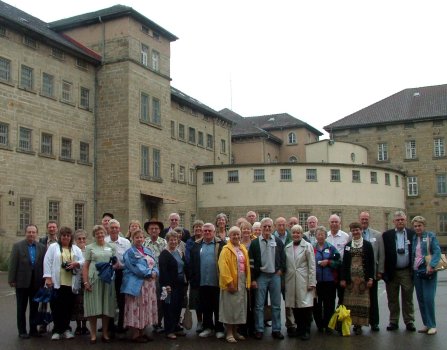
Prison at Schwäbisch Hall, where Jakob
Friedrich died |
For the descendants of the six orphaned Zeisset children who settled
in Kansas, questions arise regarding the alleged crime and death of our
great
grandfather Jakob Friedrich Zeisset. He certainly becomes a focal point
of our interest. How many other Americans make sure to include a prison
in a small town in Germany on
their vacation plans? There are things we may never learn, but we
certainly know more now than we did even a decade ago.
The prison in Schwäbisch Hall is currently undergoing renovation as a
new prison was built several years ago outside of the city and the old
one was standing vacant. It is being preserved as an historical
building and will eventually be open for some sort of business. And now
we know the “final resting place” of Jakob Zeisset, although graves are
rented in Germany and the previous occupant’s bones are removed to a
bone house.
The first Zeisset reunion in Kansas was held in Leonardville on
October 18, 1969. The
reunion was organized by Merton Zeisset, son of the youngest of the six
immigrants,
Henry Zeisset. Ninety-six persons attended this reunion. In 1970,
Merton and Ina
Zeisset and their son, Ray and his wife Carolyn visited Germany. The
second Zeisset
reunion was held in Leonardville on June 19, 1972. Since the first
reunion, some
research had been done by a professional researcher and it was learned
that Jakob
Friedrich Zeisset and his wife, Margaretha had twelve children, with
only six surviving. It was at this reunion that most of us learned of
the circumstances of the death of Jakob
Friedrich Zeisset. George Weller, son of George and Elizabeth Zeisset
Weller, reported
that he had known of the father’s imprisonment for over thirty years,
but had said
nothing. Betty Latimer, granddaughter of Bettie Zeisset Hoerman,
remembers her
grandmother telling her Jakob Friedrich had died in prison and that
there had been a fire. So there were some very well kept secrets. Since
learning of Jakob Friedrich’s
imprisonment, there have been various attempts at explaining the fact
that he was in
prison.
Ray Zeisset, Henry’s grandson, gives the following account: “After
the program,
however, George Weller approached me and said he had a story for me. He
told me that
it was something he hadn’t ever told anyone else, but thought someone
should know. [A
good thing, since he died not that long afterwards.] George said that
once there was a
crime committed in the Riley area that everyone “knew” must have been
committed by a
certain person. In talking about it, one of the Baers commented to
George that they
wouldn’t want to make the same mistake they made with Zeisset in
Kreuzfeld. Mr. Baer,
who had come to America later than our ancestors, had still been in the
community for
some time after Great Grandpa died and told this story: Great Grandpa
had been in the
“restaurant” [being good teetotalers, he didn’t say Jacob was in the
tavern and had
obviously had a few], when someone came in saying, “Zeisset, your barn
is on fire!” to
which Jacob replied, “Oh, let it burn, it’s covered by insurance.”
Jacob’s barn burned
down a few years before, and had been rebuilt with the insurance money.
There were not
private insurance companies—insurance was a government service. Based
on his
comment, Jacob was charged with fraud to collect insurance money,
convicted, sent to
prison, and the rest is history. However, as Mr. Baer continued, it
became known in the
community after Jacob’s death that it was actually the village
brickmaker who had set the
wood barn on fire because business was slow, and a new barn would
likely be made from
bricks. At the next reunion, we reported this story at the reunion.
Either during that
reunion or afterward, someone told Dad that one of Henry’s sisters
actually had seen the
brickmaker running past their house the day of the fire, and had passed
the story on to the
person telling Dad.”
Chances are that we may never know the truth.
It is particularly difficult in Germany to try to trace the history of
a purported
criminal, due to the interference of the World Wars.
There are some new leads on places to look for information regarding
Jakob Zeisset’s imprisonment, so the research process will continue.
Since the discovery of the Kreuzfeld records at the Neuenstein
Archives, we can certainly have a more accurate understanding of the
events at the Hofgut Kreuzfeld. After only a day of research, a few
basic facts were obtained but there are many more records to review. [insert
PHOTO of record pile)
In August 2006, over thirty of the six immigrant Zeisset descendants
and their friends traveled to Germany as part of the Zeisset Family
History Tour to see, as a group, where our Zeisset families lived and
worked. The first German Zeisset family reunion was held in Weisweil at
the restaurant “Hofladen Zeisset” where descendants of Matthäus Zeisset
(1830-1896), Isaak Zeisset (1839-1897) and Jakob Friedrich Zeisset
(1837-1884) met for the first time.



 Jakob Friedrich Zeisset and Margaretha Müller Zeisset, c
1877
Jakob Friedrich Zeisset and Margaretha Müller Zeisset, c
1877
 Former Zeisset residence at Kreuzfeld, 1985
Former Zeisset residence at Kreuzfeld, 1985
 Verse signed by Margaretha Zeisset, 1879
Verse signed by Margaretha Zeisset, 1879
 Page signed by Bertha Zeisset, Louise’s sister
Page signed by Bertha Zeisset, Louise’s sister Page signed by Jakob Zeisset, 1883
Page signed by Jakob Zeisset, 1883 Page signed by Johanna Luise Zeisset, Louise’s
grandmother, 1883
Page signed by Johanna Luise Zeisset, Louise’s
grandmother, 1883